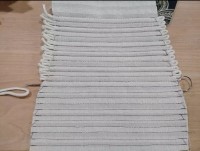Everyone needs a little support sometimes, and while the English discovered cone shaped corsets by way of the Spanish, Germany and some parts of Italy kept to a more natural form through the majority of the century. Aside from the Lengberg finds of a hundred years earlier, there are only hints at what this might have looked like. Germans in their most romantic and practical terms referred to those earlier garments as 'breast bags'. Sexy! However, most of Europe shows examples in art and lists in home inventories lined fitted garments that would definitely fit the purpose.
My intention was to make something that did not require me to use modern undergarments that I could wear comfortably all day, and provide the right silhouette for mid 1500s gowns. These two were the result:


The bodices were drafted using the Bara method from 'The Modern Maker vol.2' by Mathew Gnagy. They are made from two layers of heavy twill linen and a layer of fashion fabric. Both are made from cotton fabrics from my stash - as these were test examples I did not want to use expensive fabrics on my first run. Here is also where I tested a theory, both bodices have boning channels sewn in, and I used heavy braided cotton cord as 'boning'. There are no extant examples of this from the 1500s, and are what you could call a 'period plausible' construction. Hemp cordage of the right thickness would have been available in period, and would provide just enough support provided the boning channels were narrow. There is no way of knowing if this was something that was done, just that the materials were definitely accessible, and by their very nature would not survive well over time. Being softer than most other boning materials at the time, it would provide support while keeping a more natural shape than the English and Spanish styles of the time.
Example of cording in progress:

The skirts are straight yardage with pleats, sewn to the bodice after it was bound and eyelets sewn in. I chose to make the shoulder straps adjustable as the necklines of the overgowns I will be wearing with these will be of various sizes and it will give a lot more versatility.
I have worn these now to one day event each, and so far they are a complete success. One with a mid period German gown (rock), and the other with a later period German jacket (wams) and skirt (shauben) set. They were comfortable as well as maintained the correct shape for the gowns without any help from modern undergarments. Added bonus to the use of cotton cording – they breathe well, conform to my shape and are completely machine washable! They are also modest enough to be worn on their own around camp or for set up and tear down of an event as a pleated shirt is worn beneath it.
For later SCA period womens clothing, I very much reccomend starting from the skin out. That was the hardest lesson I learned from my early days costuming. The right undergarments absolutely affect the final fit and look of your garb, start with the proper foundations and everything will just fall together that much better. And if the world doesn't lift you up, your underwear definitely should!